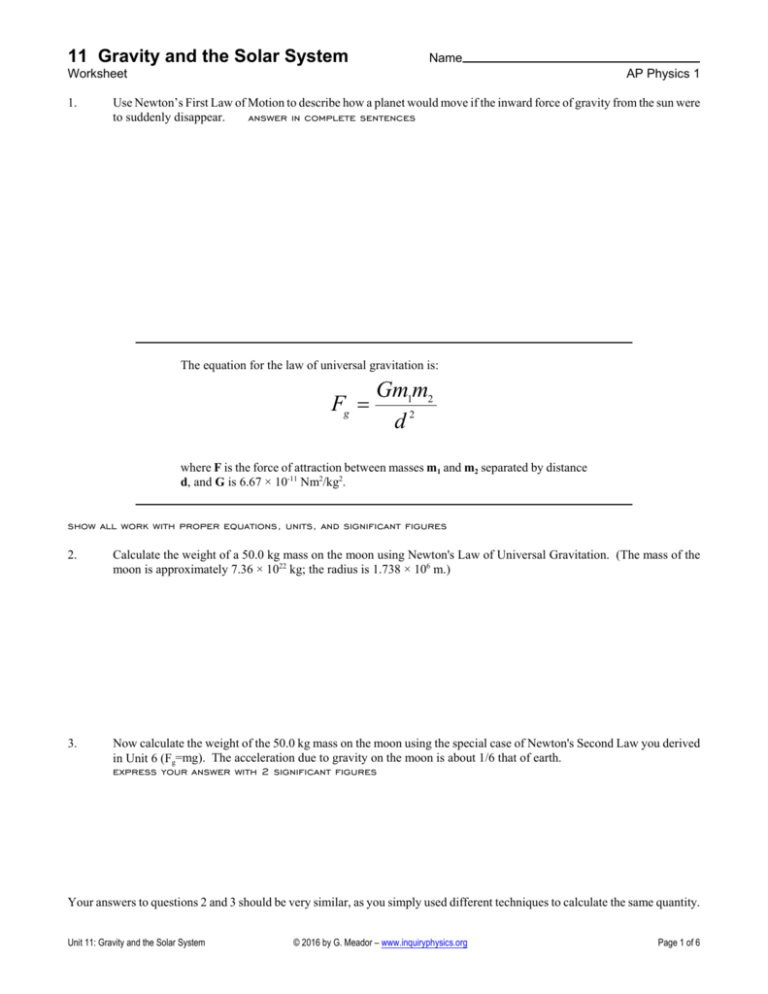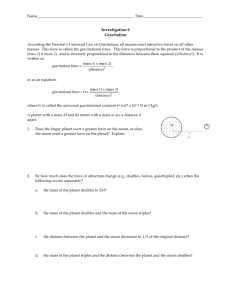Gravity & Solar System Worksheet: AP Physics 1
advertisement

11 Gravity and the Solar System Name Worksheet 1. AP Physics 1 Use Newton’s First Law of Motion to describe how a planet would move if the inward force of gravity from the sun were to suddenly disappear. answer in complete sentences The equation for the law of universal gravitation is: Fg Gm1m2 d2 where F is the force of attraction between masses m1 and m2 separated by distance d, and G is 6.67 × 10-11 Nm2/kg2. show all work with proper equations, units, and significant figures 2. Calculate the weight of a 50.0 kg mass on the moon using Newton's Law of Universal Gravitation. (The mass of the moon is approximately 7.36 × 1022 kg; the radius is 1.738 × 106 m.) 3. Now calculate the weight of the 50.0 kg mass on the moon using the special case of Newton's Second Law you derived in Unit 6 (Fg=mg). The acceleration due to gravity on the moon is about 1/6 that of earth. express your answer with 2 significant figures Your answers to questions 2 and 3 should be very similar, as you simply used different techniques to calculate the same quantity. Unit 11: Gravity and the Solar System © 2016 by G. Meador – www.inquiryphysics.org Page 1 of 6 MASS AND DISTANCE CHANGES AND THEIR GRAVITATIONAL EFFECTS Changing the mass of an object or its distance from another object will affect the gravitational force that attracts the two objects. By substituting changes in any of the variables into the equation for the Law of Universal Gravitation, we can predict how the others change. Suppose the distance of separation is reduced to one-third of its former value. Then substituting 1/3 d for d in the equation gives: Fnew Gm1m2 Gm1m2 9 Gm1m2 ) 9 Fold ( 2 1 2 1 2 1 d d ( d) 3 9 And we see the force is increased nine-fold. Suppose that the distance did not change, but one of the masses somehow is doubled. Then substituting 2m1 for m1 in the equation gives: Fnew G (2m1m2 ) Gm1m2 2 ( ) 2 Fold d2 d2 So we see the force doubles. Finally suppose that the distance of separation is doubled. Then substituting 2d for d in the equation gives: Fnew 1 Gm1m2 Gm1m2 1 Gm1m2 ( ) Fold ( 2d ) 2 4d 2 4 d2 4 And we see the force is only 1/4 as much. Use this method to solve the following problems. Write the equation and make the appropriate substitutions. 4. If both masses are tripled, what happens to the force? 5. If the masses are not changed, but the distance of separation is reduced to 2/3 the original distance, what happens to the force? 6. If the masses are not changed, but the distance of separation is tripled, what happens to the force? 7. If both masses are doubled, and the distance of separation is tripled, show what happens to the force. 8. If one of the masses is doubled, the other remains unchanged, and the distance of separation is quadrupled, show what happens to the force. Unit 11: Gravity and the Solar System © 2016 by G. Meador – www.inquiryphysics.org Page 2 of 6 CALCULATING THE WEIGHT OF AN OBJECT IN ORBIT One can use the Law of Universal Gravitation to calculate the weight of an orbiting object. The masses used in the calculation are those of the orbiting object and the planet. The distance used is the distance from the center of the circling object to the center of the planet. This means that you must add the radius of the planet to the altitude of the orbiting body. It is also important that you use meters for the distance, not kilometers or any other such unit. EXAMPLE: A 15.0 kg object orbits the planet Mars at an altitude of 200 km. What is the weight of the object if Mars has a radius of 3,430 km and a mass of 6.34 × 1023 kg? METHOD: First, change all distances into meters. One kilometer is equal to 1,000 meters, so: the altitude is 200 km 1,000 m 1,000 m 200,000 m and the radius is 3,430 km 3,430,000 m 1 km 1 km Now you must add the altitude to the radius of the planet to get the total distance from the center of the planet to the center of the orbiting object: 3,430,000 m 200,000 m 3,630,000 m Finally, plug in all of the various values into the Law of Universal Gravitation and solve: Fg Gm1m2 d2 (6.67 10 11 Nm 2 )(6.34 10 23 kg)(15kg) 6.343 1014 Nm 2 kg 2 . N 481 (3,630,000 m) 2 1318 . 1013 m 2 Show all equations and units on the following problems, and express answers with 3 significant figures. 9. At closest approach, the 722 kg Voyager 2 probe flew by Neptune at an altitude of 29,240 km. A) What was the probe’s weight at that moment if Neptune has a radius of 24,900 km and a mass of 9.99 × 1025 kg? B) Use the information from part A to calculate the acceleration due to gravity at that altitude above Neptune. Unit 11: Gravity and the Solar System © 2016 by G. Meador – www.inquiryphysics.org Page 3 of 6 10. The center of the moon and the center of the earth are 3.80 × 105 km apart. The mass of the moon is approximately 7.36 × 1022 kg, while earth's mass is about 5.98 × 1024 kg. A) Calculate the earth's pull on the moon. B) What is the size of the moon's pull on the earth? explain or show work GRAVITATIONAL FIELD STRENGTH We can adapt Newton’s Law of Universal Gravitation to predict the gravitational field strength (also called the acceleration due to gravity). For Earth: gE 11. Fg mobject Gmobject mE Nm (6.67 10 11 )(5.98 10 24 kg) 2 2 rE GmE m m kg 9.7991 2 9.80 2 and we find that 2 2 6 (6.38 10 m) s s mobject rE The space station typically orbits 400 km above the earth's surface. The earth has a mass of 5.98 × 1024 kg and a radius of 6,380 km. A) How much would a 2000 kg cargo pod for the space station weigh when it has been lifted to that orbit? B) Use your result from part A (or alternatively you can use the above derived equation for g) to determine the acceleration due to gravity at that altitude. C) Use your knowledge of circular motion to determine the orbital linear speed of the cargo pod. DENSITY CONCEPTS Unit 11: Gravity and the Solar System © 2016 by G. Meador – www.inquiryphysics.org Page 4 of 6 You also need to be comfortable with using the concept of density, often symbolized with the lowercase Greek letter rho (ρ), as the ratio of mass and volume: m V Density can be expressed in kg/m3 and can also be expressed as a fraction of the density of Earth, ρE. Knowing that the volume of a sphere is given by V 4 3 r , we can make various predictions. 3 For example, if a newly discovered plant has a density 2/3 that of Earth, or 2 1 E , and radius half that of Earth, or rE 2 3 , then we could predict its surface gravitational field in terms of that of Earth’s gE: First we need to express the planet’s mass in terms of the Earth’s mass mE. Since m=ρV then m 4 3 ( rE 3 ) and thus the new 3 2 4 1 2 1 2 1 4 planet’s mass is m E ( rE )3 E ( rE )3 mE mE . 3 24 3 2 3 3 2 12 1 1 G ( mE ) GmP 12 GmE 1 4 GmE 4 1 12 gP 2 2 g E (9.8 m / s 2 ) 3.27 m / s 2 2 2 1 3 12 12 1 rE rP 1 rE Next we calculate ( rE ) 2 2 2 12. Calculate the gravitational field strength, to 3 significant figures, of a planet that is twice as dense as Earth and which has a radius ½ that of the Earth. 13. Calculate the density of a planet, in terms of the Earth’s density ρE , if it is the same size as Earth but has a gravitational field strength that is 1.20 times that of Earth. Unit 11: Gravity and the Solar System © 2016 by G. Meador – www.inquiryphysics.org Page 5 of 6 GRAVITATIONAL VS. INERTIAL MASS The gravitational mass of an object one uses in Fg=mg happens to be the same as the inertial mass in GF=ma. These different types of mass are measured in different ways: the gravitational mass is a static measurement taken using a scale or balance when the object is at rest or in equilibrium, while the inertial mass is a dynamic measurement taken when the object is being accelerated. Classify each method of measurement by writing I for inertial mass or G for gravitational mass in the blank beside each description: 14. Using a spring scale to suspend the object and recording the reading. 15. Attaching the object to a spring of known spring constant, allowing it to oscillate freely horizontally, and measuring the period. 16. Placing the object on one side of a double-pan balance and adding known masses to the other pan until it balances. 17. Attaching the object to a force sensor, pulling the object across a very smooth surface, and measuring acceleration. 18. Thus far in the course we have ignored that on the Earth’s surface an object must have a slightly unbalanced force to rotate with the Earth, pretending that the normal force precisely balances the object’s weight. A student with a mass of 65.0 kg stands at the equator. The radius of the Earth is 6.38×106 m, and of course it rotates once per day. A) What is the magnitude of the centripetal force (in newtons) required to keep the student on the Earth’s surface? (Don’t do a free body diagram and force analysis yet; just use the centripetal force and other circular motion equations.) B) Since the centripetal force is unbalanced, what is the true magnitude of the normal force on the student? (The student weighs 637 N, and with a free body diagram and ΣF=ma you should find the normal force is actually less than 637 N.) Unit 11: Gravity and the Solar System © 2016 by G. Meador – www.inquiryphysics.org Page 6 of 6









